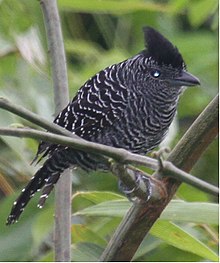Not to be confused with bamboo antwren, now known as Ihering's antwren.
| Bamboo antshrike | |
|---|---|

| |
| Conservation status | |
 Least Concern (IUCN 3.1) | |
| Scientific classification | |
| Domain: | Eukaryota |
| Kingdom: | Animalia |
| Phylum: | Chordata |
| Class: | Aves |
| Order: | Passeriformes |
| Family: | Thamnophilidae |
| Genus: | Cymbilaimus |
| Species: | C. sanctaemariae |
| Binomial name | |
| Cymbilaimus sanctaemariae Gyldenstolpe, 1941 | |

| |
The bamboo antshrike (Cymbilaimus sanctaemariae) is a species of bird in subfamily Thamnophilinae of family Thamnophilidae, the "typical antbirds". It is found in Bolivia, Brazil, and Peru.
Taxonomy and systematics
Until the 1980s what is now the bamboo antshrike was treated as a subspecies of the fasciated antshrike (C. lineatus). The two are the only species in genus Cymbilaimus. The bamboo antshrike is monotypic.
Description
The bamboo antshrike is 16 to 17 cm (6.3 to 6.7 in) long and weighs 28 to 33 g (0.99 to 1.2 oz). This species exhibits significant sexual dimorphism. Both sexes have a small crest, a dark brown iris, and a somewhat heavy bill with a hook at the end like true shrikes. Adult males have a black forehead and crown; the rest of their plumage is thin black and white bars. Females have a rufous crown with black tips on the crest feathers. Their upperparts and tail have thin dark brown and pale yellowish brown bars, their throat is plain buffy white, and the rest of their underparts are mostly plain cinnamon-buff with darker barring on the sides and flanks.
Distribution and habitat
The bamboo antshrike is found in the western Amazon Basin of southeastern Peru, western Brazil, and northwestern Bolivia. In Peru it occurs in the departments of Ucayali, Cuzco, Madre de Dios, and Puno. In Brazil it occurs in Acre and Rondônia states, and in Bolivia the departments of Pando, La Paz, and Beni.
The bamboo antshrike almost exclusively inhabits stands of bamboo, typically of genus Guadua, in humid lowland and foothill forest. There it favors the upper levels of the bamboo. It sometimes is found in dense tangles of vines in floodplain forest (even with no bamboo), where it is more broadly seen from the mid-storey to the canopy. In elevation it ranges up to about 1,450 m (4,800 ft).
Behavior
Movement
The bamboo antshrike is presumed to be a year-round resident throughout its range.
Feeding
The bamboo antshrike's diet has not been detailed but is known to include insects. It forages singly or in pairs and occasionally joins mixed-species feeding flocks as they pass through its territory. It forages mostly in the crown of bamboo stands but also in vine tangles; it may go as high as 20 m (65 ft) above the ground in trees above bamboo stands. It feeds mostly by gleaning or making short sallies from a perch during pauses while hopping along branches and bamboo stems. It occasionally investigates clusters of dead leaves.
Breeding
Nothing is known about the bamboo antshrike's breeding biology.
|
Songs and calls Listen to bamboo antshrike on xeno-canto |
Vocalization
The bamboo antshrike's song is "a loud, slightly descending series of 8-15 ringing metallic tchink notes". Its calls are "a sharp tchew! note" that is often made in a series, "a thin, dry rattle", and "a whining ewwee?".
Status
The IUCN has assessed the bamboo antshrike as being of Least Concern. It has a fairly large range; its population size is not known and is believed to be decreasing. No immediate threats have been identified. It is considered fairly common in appropriate habitat, which however is patchily distributed. "Brazilian populations, particularly those in Rondônia, could be at risk as a result of complete deforestation in some areas."
References
- ^ BirdLife International (2016). "Bamboo Antshrike Cymbilaimus sanctaemariae". IUCN Red List of Threatened Species. 2016: e.T22701226A93818418. doi:10.2305/IUCN.UK.2016-3.RLTS.T22701226A93818418.en. Retrieved 14 April 2024.
- ^ Gill, Frank; Donsker, David; Rasmussen, Pamela, eds. (January 2024). "Antbirds". IOC World Bird List. v 14.1. Retrieved 4 January 2024.
- Remsen, J. V., Jr., J. I. Areta, E. Bonaccorso, S. Claramunt, G. Del-Rio, A. Jaramillo, D. F. Lane, M. B. Robbins, F. G. Stiles, and K. J. Zimmer. Version 4 March 2024. Species Lists of Birds for South American Countries and Territories. https://www.museum.lsu.edu/~Remsen/SACCCountryLists.htm retrieved March 5, 2024
- Pierpont, N.; Fitzpatrick, F.W. (1983). "Specific status and behavior of Cymbilaimus sanctaemariae, the Bamboo Antshrike, from southwestern Amazonia". Auk. 100 (3): 645–652. doi:10.1093/auk/100.3.645. Retrieved April 13, 2024.
- ^ Zimmer, K. and M.L. Isler (2020). Bamboo Antshrike (Cymbilaimus sanctaemariae), version 1.0. In Birds of the World (J. del Hoyo, A. Elliott, J. Sargatal, D. A. Christie, and E. de Juana, Editors). Cornell Lab of Ornithology, Ithaca, NY, USA. https://doi.org/10.2173/bow.bamant1.01 retrieved April 14, 2024
- ^ van Perlo, Ber (2009). A Field Guide to the Birds of Brazil. New York: Oxford University Press. pp. 230–231. ISBN 978-0-19-530155-7.
- ^ Schulenberg, T.S., D.F. Stotz, D.F. Lane, J.P. O’Neill, and T.A. Parker III. 2010. Birds of Peru. Revised and updated edition. Princeton University Press, Princeton, New Jersey plate 157
| Taxon identifiers | |
|---|---|
| Cymbilaimus sanctaemariae | |
